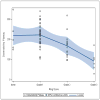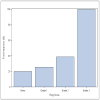Severity of endoscopically identified esophageal rings correlates with reduced esophageal distensibility in eosinophilic esophagitis
- PMID: 27200524
- PMCID: PMC5757503
- DOI: 10.1055/s-0042-107340
Severity of endoscopically identified esophageal rings correlates with reduced esophageal distensibility in eosinophilic esophagitis
Abstract
Background/aims: A grading system for the endoscopic features of eosinophilic esophagitis (EoE) has recently been validated. The EoE Endoscopic Reference Score (EREFS) incorporates both inflammatory and remodeling features of EoE. High resolution impedance planimetry using the functional luminal imaging probe (FLIP) is a technique for quantification of esophageal remodeling. The aim of this study was to evaluate the association between endoscopic severity with EREFS and esophageal distensibility as measured with the FLIP.
Methods: Upper gastrointestinal endoscopy with biopsies and FLIP were performed in 72 adults with EoE. Endoscopic features of edema, rings, exudates, furrows, and stricture were evaluated using the EREFS system. Esophageal distensibility metrics obtained by FLIP, including the distensibility slope and distensibility plateau, were compared with EREFS parameters. Bivariate associations between EREFS parameters and histologic eosinophil density were assessed.
Results: Higher ring scores were associated with a lower distensibility plateau (rs = -0.46; P < 0.0001). An association was found between severity of exudates and eosinophil density (rs = 0.27; P = 0.02), as well as between furrows and eosinophil density (rs = 0.49; P < 0.0001). Severity of exudates and furrows, and degree of eosinophilia were not associated with the distensibility parameters.
Conclusions: Endoscopic assessment of ring severity can serve as a marker for esophageal remodeling and may be useful for food impaction risk stratification in EoE. Eosinophil count was not significantly associated with esophageal distensibility, consistent with previous reports of dissociation between inflammatory activity and fibrostenosis in EoE. Endoscopic inflammatory features show a weak correlation with histopathology but should not replace histologic indices of inflammation.
© Georg Thieme Verlag KG Stuttgart · New York.
Conflict of interest statement
Figures





Comment in
-
Endoscopy in eosinophilic esophagitis: within or beyond the reach of the endoscope?Endoscopy. 2016 Sep;48(9):785-6. doi: 10.1055/s-0042-108575. Epub 2016 Aug 29. Endoscopy. 2016. PMID: 27571584 No abstract available.
-
French comment on article: Severity of endoscopically identified esophageal rings correlates with reduced esophageal distensibility in eosinophilic esophagitis.Endoscopy. 2016 Sep;48(9):873. doi: 10.1055/s-0042-113569. Epub 2016 Aug 29. Endoscopy. 2016. PMID: 27571594 No abstract available.
References
-
- Liacouras CA, Furuta GT, Hirano I, et al. Eosinophilic esophagitis: updated consensus recommendations for children and adults. J Allergy Clin Immunol. 2011;128:3–20. e6. quiz 1–2. - PubMed
-
- Aceves SS, Newbury RO, Dohil R, et al. Esophageal remodeling in pediatric eosinophilic esophagitis. J Allergy Clin Immunol. 2007;119:206–212. - PubMed
-
- Lucendo AJ, Arias A, De Rezende LC, et al. Subepithelial collagen deposition, profibrogenic cytokine gene expression, and changes after prolonged fluticasone propionate treatment in adult eosinophilic esophagitis: a prospective study. J Allergy Clin Immunol. 2011;128:1037–1046. - PubMed
MeSH terms
Grants and funding
LinkOut - more resources
Full Text Sources
Other Literature Sources
Medical

